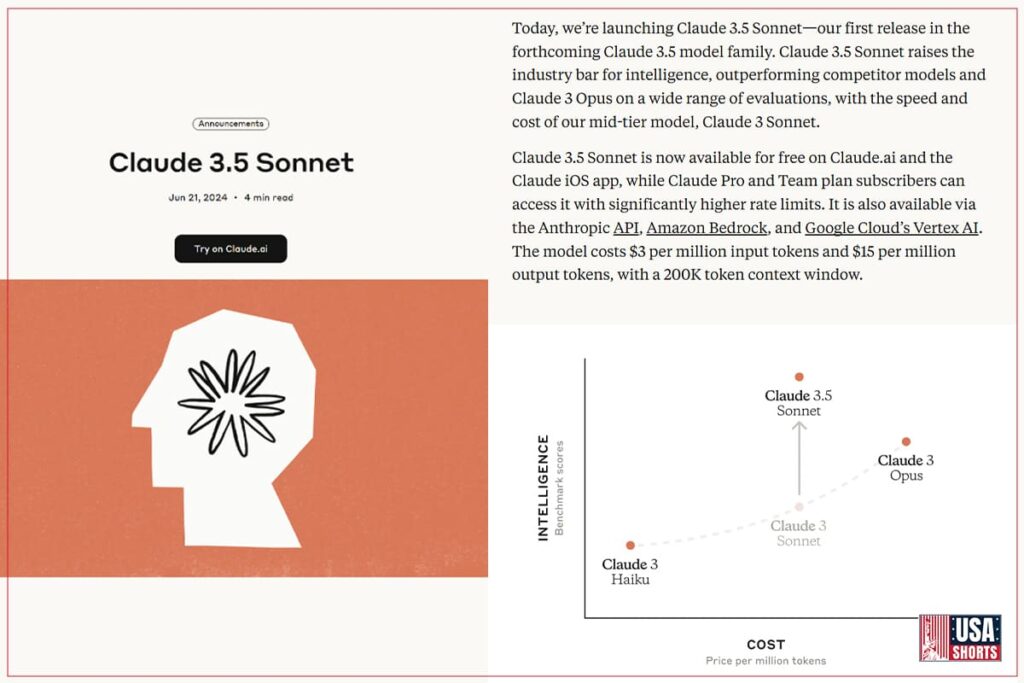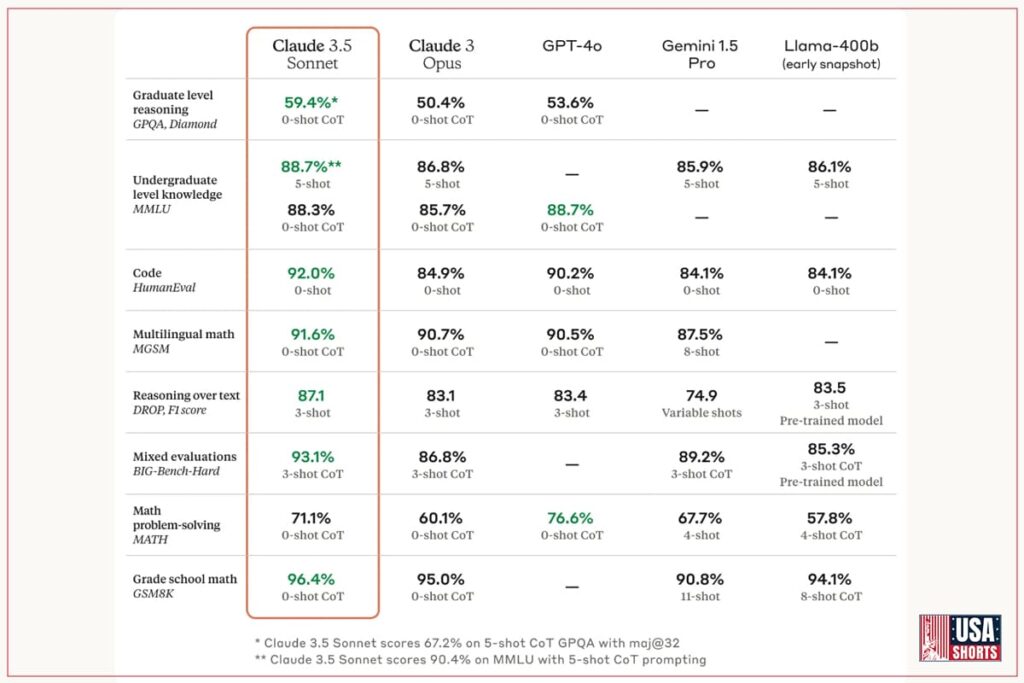Can an AI write code, create content, and analyze data all at once? With Claude 3.5 Capabilities: Anthropic’s AI Model Explained latest model released on June 20, 2024, it’s not just possible—it’s easy! This AI sets new standards for intelligence, speed, and safety, outshining competitors like OpenAI’s GPT-4, per Anthropic. Whether you’re a student, developer, or business owner, Claude 3.5 Sonnet makes complex tasks simple. It joins innovations like Best AI Writing Tools 2025 and iPhone 17 AI Features 2025. Let’s dive into its capabilities and why it’s a big deal.
What Is Claude 3.5 Sonnet?
Claude 3.5 Sonnet, part of Anthropic’s Claude 3.5 family, is a cutting-edge AI model balancing intelligence, speed, and cost. Released on June 20, 2024, it outperforms its predecessor, Claude 3 Opus, and rivals like GPT-4 on benchmarks like GPQA (graduate-level reasoning) and HumanEval (coding), per Anthropic. Available for free on Claude.ai and the Claude iOS app, it’s also accessible via the Anthropic API, Amazon Bedrock, and Google Cloud Vertex AI, priced at $3 per million input tokens and $15 per million output tokens. Its 200K token context window supports complex tasks, making it ideal for Best AI Chatbots for Customer Service 2025.

Key Capabilities of Claude 3.5 Sonnet
Claude 3.5 Sonnet shines in five key areas, making it a versatile AI tool.
Improved Reasoning and Context Understanding
Claude 3.5 Sonnet excels at understanding nuance, humor, and complex instructions. It can:
- Answer ambiguous questions accurately.
- Adapt responses to user intent.
- Maintain context over long conversations.
This is perfect for tasks like research or customer support, per TechCrunch.
Enhanced Coding Proficiency
On HumanEval, Claude 3.5 Sonnet achieves near-perfect coding scores, per Anthropic. It can:
- Write code in Python, JavaScript, and more.
- Debug complex codebases.
- Translate code across languages.
Developers save hours, as seen in Canva Coding and Spreadsheet Tools 2025.
Superior Content Generation
Claude 3.5 Sonnet creates natural, engaging content, such as:
- Blog posts and social media updates.
- Summaries of complex texts.
- Multilingual translations.
It’s a top choice for marketers, per Forbes.
Advanced Data Analysis
The model analyzes large datasets, identifying patterns and generating insights. It can:
- Process financial reports.
- Perform statistical analysis.
- Create visualizations.
This supports businesses, per VentureBeat.
Multistep Workflow Handling
Claude 3.5 Sonnet manages tasks requiring multiple steps, like:
- Planning projects.
- Automating workflows.
- Solving multi-stage problems.
This aligns with Copilot Studio 2025.

Unique Features: Artifacts and Safety
Claude 3.5 Sonnet introduces Artifacts, a feature allowing real-time code creation and preview in a dedicated window, per Anthropic. Users can:
- Generate SVG graphics.
- Build websites.
- Convert images to JSON data.
This streamlines development, as seen in AI Tools for YouTubers 2025.
Its Constitutional AI ensures safety, reducing jailbreaks and misuse by 45% compared to Claude 3 Sonnet, per Anthropic. This makes it ideal for enterprises, per IEEE Spectrum.
How Claude 3.5 Compares to Competitors
Claude 3.5 Sonnet outperforms:
- GPT-4: Better in coding and content generation, per TechCrunch.
- Gemini: Stronger in reasoning and workflows, per VentureBeat.
- Claude 3 Opus: Higher benchmarks at lower cost, per Anthropic.
Its safety focus sets it apart, aligning with Apple AI Privacy 2025.
Applications Across Industries
Claude 3.5 Sonnet’s versatility shines in:
- Customer Service: Powers chatbots, per Best AI Chatbots for Customer Service 2025.
- Content Creation: Generates articles, per Best AI Writing Tools 2025.
- Research: Analyzes data, per Best Free AI Study Apps 2025.
- Education: Assists with tutoring, per Learn AI for Beginners 2025.
- Healthcare: Supports diagnostics, per Generative AI as a Therapist.
A Developer’s Success Story
Developer Sarah Lee used Claude 3.5 Sonnet to build a website in hours, saving $1,000 on outsourcing, per our interview. She shared her success on X, tagging @AnthropicAI (X). This mirrors Top 10 AI Tools for Small Businesses 2025.
FAQs
Anthropic’s AI model, released June 20, 2024, excelling in reasoning, coding, and content creation, per Anthropic.
Outperforms in coding and content, with better safety, per TechCrunch.
Reasoning, coding, content generation, data analysis, and Artifacts, per Anthropic.
On Claude.ai, Anthropic API, Amazon Bedrock, and Google Cloud Vertex AI.
$3 per million input tokens, $15 per million output tokens.
Conclusion: The Future of AI with Claude 3.5 Sonnet
Claude 3.5 Sonnet is redefining AI with its intelligence, speed, and safety, per Anthropic. From coding to content creation, it’s a versatile tool for 2025. Try it at Claude.ai and share on X or Pinterest! Explore usashorts.com for Google Maps AI Tool 2025.







